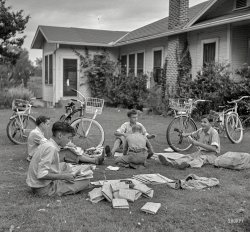
MAY CONTAIN NUTS

Search Shorpy
SHORPY ART

Framed or unframed, desk size to sofa size, printed by us in Arizona and Alabama since 2007. Explore now.
Join and Share
Ad-Free Shorpy
Shorpy is funded by you. Patreon contributors get an ad-free experience.
Learn more.

Recent comments
- Recent view
- Hudson’s Big Store
- Say what??
- Grapes?!
- A Beautiful Moment
- Such joy
- Bethune-Cookman University today...
- Yellow sky at morning
- Side Winder
- Air Quality?
- Sojourner Truth riot
- None were so blind(ed)
- The less famous sister
- Good ol' days?
- Rise and Fall
- Goo Goo Ga Joob
- Ticket Retention
- Not the only one
- Vagaries of War
- Killed by Amtrak
- Back to the Future
- Wanted --
- If you can't stand the light
- Centralized Traffic Control, I believe
- What's really happening
- Heckuva remote control!
- Sometimes — Things Go Bump!
- I SEE THE LIGHT
- Union Switch and Signal Company
- Get That Light Out Of My Eyes
Member Photos
The Shorpy
Print Emporium
Print Emporium
Search Shorpy
Search results -- 30 results per page
- Hidden Dangers: 1920
- ... pay a dime to see that. How about you?
(The Gallery, Bicycles, D.C., Kids, Movies, Natl Photo) ... Posted by Dave - 08/13/2013 - 4:32pm -
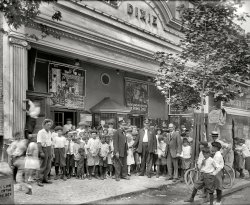
- Manley Boy: 1917
- ... given the birth information himself.
(The Gallery, Bicycles, Kids, Lewis Hine, OKC) ... Posted by Dave - 05/04/2018 - 11:31am -
![Manley Boy: 1917 March 15, 1917. Oklahoma City, Oklahoma. "Manley Creasson [Creason], 914 West Sixth Street. Messenger #6, MacKay Telegraph Co. Says he is 14; school records say 13. Says he has steady job -- 'Been a messenger for years. Get $15 for 2 weeks' pay'." Silver gelatin print by Lewis Wickes Hine. View full size.
Hard LifeIf my Ancestry.com research is correct, Manley died in 1941 at the age of 38 in Dallas, after serving some time in Leavenworth Prison in the 1930s. In the 1930 census, he is shown as a married boarder, with no job.
A Manly Man, to the EndManly R. Creason (the correct spelling) was born in, either, 1902 0r 1903, depending upon which account is correct. He died in Texas in 1941 of tuberculosis
The School was Wrong (at least according to the State of Texas)If you go by his death certificate issued in Texas in 1941 (he died from pulmonary tuberculosis at the age of 38).
As per the 1940 census he and his wife, Jewell, were the owners of either a cafe (1940 census) or a 'recreational club' (death certificate).
That said, his census records each have him listed as being born around 1904, so perhaps Texas was wrong after all.
They had a daughter, Mary George, and Jewell lived until 1985, apparently never remarrying as she retained her maiden name according to her record in the Social Security Death index.
Birthdate According to his headstone he was born in 1903.
Track StandIt looks to me that Manley's bike isn't in motion, that he is executing a "track stand," a technique in which a rider balances his bike with little to no forward motion. His pedal cranks are horizontal and the front wheel is turned slightly, which is the signature look of a track stand.
AwesomeThat's what my son said when I shared this Shorpy with him this AM. He's a bike messenger in Chicago and has shared it with everyone at work!
Reliability of Information on Death CertificatesA deceased person's vital statistics on a death certificate are usually provided by an informant. The informant may be anyone, such as a relative or a neighbor.
Those vital statistics, such as birthdate, may therefore be subject to error as informants may not be able to provide accurate data. Even spouses don't always know the correct birthdates or birth places for their mates.
The medical information on the certificate is usually provided by a doctor or some other medical official.
In the case Mr. Creason, I would tend to think that the birth data provided by the census is probably closer to the truth than that given in the death certificate. He may have given the birth information himself.
(The Gallery, Bicycles, Kids, Lewis Hine, OKC)](https://www.shorpy.com/files/images/SHORPY-04020u.thumbnail.jpg)
- Gifted Children: 1941
- ... see a boa constrictor grab a stevedore.
(The Gallery, Bicycles, Christmas, Kids) ... Posted by Dave - 12/22/2015 - 12:28pm -
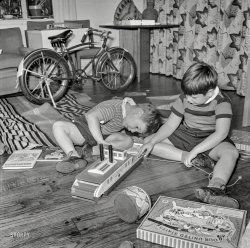
- Postal Boys: 1911
- ... the over the road delivery business.
(The Gallery, Bicycles, Kids, Lewis Hine) ... Posted by Dave - 08/13/2013 - 3:59pm -
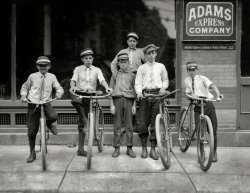
- The Sherman: 1899
- ... simply another name for saloon.
(The Gallery, Bicycles, DPC, Streetcars) ... Posted by Dave - 09/16/2018 - 5:38pm -
![The Sherman: 1899 Mount Clemens, Michigan, circa 1899. "Sherman House." And its Sample Room. 8x10 inch glass negative, Detroit Photographic Company. View full size.
119 Years LaterNorthwest corner of Cass and Gratiot where the Sherman House used to stand. Now a Macomb County office building housing, among other things, the offices of the Friend of the Court.
The Object across the streetWith the Round Globe and appears it would be colorful. Is It a fancy Barber Pole?
Streetcar tracks and---dirt roads, I didn't know they coexisted.
Stone TabletsThe stone tablets standing on edge in the gutters were to prevent the utility poles from being struck by wagon wheel hubs. Often you will also see many spirally wound wraps of steel wire around pole bases, or steel sheet, to similarly protect poles from damage. It must have been a real problem.
Obsolete CommunicationsTwo types of obsolete communication in this picture struck me. The paperboy and Western Union bike messengers.
What the heck would they be sampling?
[Booze. - Dave]
From the Encyclopedia of Chicago:
A second type of drinking place evolved from grocers and provisioners who began to sell hard liquor in wholesale quantities. At first, their sample rooms were places where customers could taste-test the stock; long afterward, "sample room" became simply another name for saloon.
(The Gallery, Bicycles, DPC, Streetcars)](https://www.shorpy.com/files/images/SHORPY-4a03997a.thumbnail.jpg)
- INB: 1904
- ... was demolished in 1970 . - Dave]
(The Gallery, Bicycles, DPC, Indianapolis) ... Posted by Dave - 07/16/2018 - 9:22am -
![INB: 1904 "Indiana National Bank, Virginia Avenue." Continuing our tour of 1904 Indianapolis, sponsored by Omega Oil. Trial Bottle only 10 cents! 8x10 inch dry plate glass negative, Detroit Photographic Company. View full size.
Giving it the ZipI think this is a building at the corner of Washington and Virginia street. It was replaced with Merchant's bank building nicknamed the "zipper bank", and remodeled for the 3rd time, now houses a Brazilian steakhouse.
[Actually the bank, at 3 Virginia Avenue, was demolished in 1970. - Dave]
(The Gallery, Bicycles, DPC, Indianapolis)](https://www.shorpy.com/files/images/SHORPY-4a11602a.thumbnail.jpg)
- Minor Heroes: 1910
- ... Maclay. View full size.
(The Gallery, Adam Maclay, Bicycles, New Zealand) ... Posted by Dave - 10/13/2013 - 3:01pm -
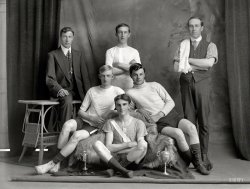
- Boy, Bike, Boat: 1906
- ... never post too many Tashmoo pictures.
(The Gallery, Bicycles, Boats & Bridges, Detroit Photos, DPC) ... Posted by Dave - 10/08/2014 - 6:11pm -
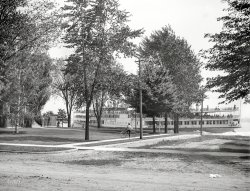
- College Ices: 1908
- ... thyself. Or maybe that was the problem?
(The Gallery, Bicycles, DPC, Stores & Markets) ... Posted by Dave - 11/17/2013 - 1:33pm -
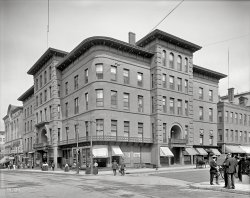
- Belle Isle Bikes: 1899
- ... Company. View full size.
(The Gallery, Bicycles, Detroit Photos, DPC) ... Posted by Dave - 09/26/2017 - 10:47am -
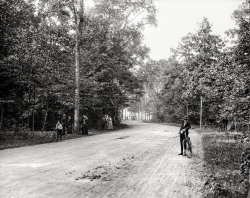
- Boy on a Bike: 1900
- ... but the same winsome smile.
(The Gallery, Bell Studio, Bicycles, D.C., Kids) ... Posted by Dave - 12/27/2016 - 10:42pm -
![Boy on a Bike: 1900 "Boy on bicycle ca. 1895-1916" is the improvised title of this 5x7 dry plate from the C.M. Bell portrait studio in Washington, D.C., whose legacy is a collection of some 30,000 glass negatives recently digitized and catalogued by the Library of Congress after spending the better part of a century in "a succession of basements and farm buildings." View full size.
Background Fungus?The background was a bit of a puzzle until I recalled something I learned right here on Shorpy: Old negatives can be attacked by fungus. I surmise this is a severe case of fungal attack.
(Makes one realize how much of a blessing digitization is.)
[The culprit here is most likely mold resulting from water damage. -Dave]
The headlight is interesting. It might be a carbide/acetylene lamp like some underground miner's headlamps, or it might be an early dry cell electric.
Many years ago, I saw a British-made bicycle headlamp that used a rectangular 3-volt battery which was two cylindrical zinc-carbon cells in a single enclosure. It had brass contact strips on the top and front. I believe these batteries have been obsolete since circa WW2.
Judging by the apparent size of this lamp, it might be an electric lamp which takes one of these 3v. batteries. But, the top looks somewhat like a vent, so acetylene still seems like a good guess.
PoshA well-dressed kid and a well-appointed bicycle (headlight!)plus, of course, his presence in a photo studio suggests that this is a child of privilege. Who did he grow up to be?
He grew to be...TV Tommy Ivo before he got his 4 engine dragster.
DigitizationTrue, it doesn't get moldy, but I wonder if a flash drive stored in a damp basement for 100 years would yield any images?
Oil?There seems to be a long springy bracket on the front lamp and, together with the vent, suggests to me that there is paraffin (kerosene?) in the bottom tank. Without good springing the flame would go out when shaken on a bumpy road.
The valve on the rear tyre looks shorter than the UK one used at that time; would it have a tubular rubber insert?
Little Lord Fauntleroy?Without the curly hair, but the same winsome smile.
(The Gallery, Bell Studio, Bicycles, D.C., Kids)](https://www.shorpy.com/files/images/SHORPY-25849a.thumbnail.jpg)
- Greetings From Asbury Park: 1914
- ... nothing on wheels rolled in Ocean Grove on Sunday. Not bicycles or baby carriages. Everyone walked. Even cars had to be parked ... Posted by Dave - 07/23/2012 - 6:44pm -
![Greetings From Asbury Park: 1914 "Asbury Park, New Jersey." The North End Hotel on the Ocean Grove side of the boardwalk circa 1914. George Grantham Bain Collection. View full size.
"In the Beautiful Seaside Air"That's the title of a Victor record by Billy Murray and the Peerless Quartet, circa 1915. My late Grandma's favorite vacation spot was Asbury Park, and I'm glad that she didn't live long enough to see the boardwalk fall into ruin. One of the large buildings (the Exhibition Hall?) once had a museum of player pianos and mechanical music boxes, which all worked. I wonder what happened to them?
Postcard View
Trim and FitA fantastic picture. Caught in mid-conversation, everyone seems so animated, even the onlookers on the benches. The men, as always, were in ties, sport coats and hats, even though it was probably summer. But what is really astonishing is that absolutely everyone in that picture is trim and fit, no fatties in sight anywhere that I can detect. Ninety-five years later, another picture taken in the same area would undoubtedly yield a broad selection of suburban New Jersey heavyweights.
In case of fire -- run for your lifeThe lace on each of those dresses is gorgeous, and the expressions on the faces make you feel that you were really there. But on the far right is a bucket labeled for fire. If you tried to put out anything larger than a burning napkin with that little bucket you would be in sorry shape. There is no apparent supply of water with the bucket. What did they expect you to do, run off the boardwalk, over to the waves, and run back, one bucket at a time, to splash the fire out?
[Weren't fire buckets usually full of sand? - Dave]
Fourth of July, Asbury ParkGossip overheard on the boardwalk this day: "Did you hear, the cops finally busted Madam Marie for tellin' fortunes better than they do?"
Feels like I am right there.I love that you can get all the root beer and ginger ale you want for 5 cents!
A Derby?Guy at bottom right:
"You're on holiday, man - where's your straw boater?"
DynamicsWhat a wonderful negative. I marvel at these treasures, some of which are well over 100 years old. I wonder how well our current generation of digital images will fare over this same time. My fear is that most of them will be lost forever. (I've already heard people bemoaning the loss of pictures they were to "busy" to transfer from an old computer to a new one.) But I digress.
This picture is a wonderful microcosm of American society. There are dynamics at work here. A father and his "soon-to be flapper" daughter just exiting the bottom of the frame. Three young girls walking up the boardwalk, one of whom seems to be casting an eye back ... to what? (a rival?) Not far away is an animated discussion between three men. A little farther up, a family (?) of six females and two small boys, stretched out in a line. A man all alone, suffering from a cold (?) and on and on. Until up on the right, most disturbing of all, a small knot of men clustered at the swimming pool fence.
Ansel Adams had the Zone System. I'm working on the points system. First I points it here, and then I points it there ...
So Many ScenariosOne need not walk into the "SCENARIO" entrance to see them. For free, a lot of them are playing out right here. Here are some favorites:
The Prohibition is clearly in force here. Against smiling. What a grim bunch of happy vacationers.
The man talking in front right to the other two - he is flashing "East Side," homie. I hope he got the right sign back, for the sake of the man in the bowler.
The man, dead center, blowing his nose. Look at the wide latitude he is given. No wonder. A runny nose in 1914 was fearsome.
I give up trying to see what the young girl, front bottom center, is turning around to spy upon. If a young man is returning that gaze, about 20-30 people might be alive today as a direct result.
The Summer of '47Wow! This brought me back to 62 years ago. I spent a week in Ocean Grove with a family of neighbors while my dad was on a business trip in Europe. High spots of the time there was at the Carousel on the Asbury side of the lagoon, going for the brass ring, and seeing a performance of "Pirates of Penzance" in the huge old wooden auditorium. Ocean Grove was an old Methodist tent-meeting resort back then, like Ocean City farther down the Jersey Coast, and Oak Bluffs up on Martha's Vineyard. At Saturday midnight, chains were put up on all streets entering the Grove to prevent any auto traffic on Sundays. I wonder if they still do that there. And thanks for putting up the old postcard to reorient me.
Everyone is so thinin a good way.
"By the sea........by the sea, by the beautiful sea,
you and me, you and me,
oh, how happy we'll be..."
I don't know the rest of the words but it seems to precisely describe this photo of the halcyon days of 1914. Looks like a "barbershop quintet" of five similarly dressed males who just might be entertainers. Wish I was there.
Oh, the clothes!I know, I know. If all we talked about in Shorpy comments was clothes, we could still be here all day. But this is one of my favorite fashion eras, where the elaborate styles of the nineteenth century were enjoying a happy marriage with the simpler, more practical ones of the twentieth. I could spend hours just poring over the lace insets the black-hatted lady in the lower right is sporting on her summer frock. The bemiddied teen girls at center are adorable, yet comfortable enough to play with the boys. And every man is Maurice Chevalier!
Re: Can you hear me now?Is that person serious? You get a lot of comments like this, Dave?
[No comment. - Dave]
Can you hear me now?This is such a detailed recreation, it almost had me fooled. The man with the cell phone gives it away as a fake. He is about even with the man blowing his nose, a few paces to his right.
Clever, Dave. But not clever enough :-)
[Seeing as how his hand is empty, he's probably not chatting on his cell. - Dave]
It was a jokeUm, I was joking. I guess I sounded too much like some of the genuine comments that insist Dave is trying to pull the wool over our eyes in some fashion.
I'll try to be more obvious in my attempt at humor from now on.
Love the site, and this picture in particular.
Sunday DriversBob, sorry but they no longer put up the chains across the roads on Sunday. It ended back in the Seventies. Someone from New York, vacationing in Ocean Grove, complained that a Newspaper Delivery man was allowed to enter the Grove in the early hours on Sunday to deliver the Sunday paper. A lawsuit ensued and now the chains are gone. At one time nothing on wheels rolled in Ocean Grove on Sunday. Not bicycles or baby carriages. Everyone walked. Even cars had to be parked either in garages or out of town. Not on the streets of Ocean Grove. Most everything in Asbury Park and Ocean Grove, from that time, is gone. Even the carousel that had the brass ring is gone. I was born in Neptune and raised there about 60 years ago, and still live down by the beach.
(The Gallery, Asbury Park, G.G. Bain, Sports)](https://www.shorpy.com/files/images/13688u_0.thumbnail.jpg)
- Instant Messenger: 1913
- ... poorest downtrodden sections of town.
(The Gallery, Bicycles, Kids, Lewis Hine) ... Posted by Dave - 03/28/2014 - 7:41pm -
![Instant Messenger: 1913 November 1913. Shreveport, Louisiana. "Western Union messenger No. 2, fourteen years old. Says he goes to the Red Light district all the time." Glass negative by Lewis Wickes Hine for the National Child Labor Committee. View full size.
Telegram for Miss ScarletAs pointed out in another photo's comment, Mr. L. W. Hine seems to have had a broad assortment of moral axes to grind. I'd be surprised if prostitutes were really frequent recipients of Western Union Telegrams. The bicycle's tires look to be skinny like modern day bike tires are. I guess the big balloon tires as used on the Schwinns that I remember came later.
Bike to the FutureThe cars from 1913 have hardly any resemblance to the ones made these days other than having four wheels and a body, but this bike is within a few percent of a modern coaster brake bike. Sure, a few subtle details are different, but wheels and the drive train could have been made last week.
Red LightMy question has always been with regards to this "red light district" line that Hine usually put with his messenger photos is, are the prostitutes ordering "drugs" and abusing them? Were the drug stores not under strict scrutiny like today? I imagine this to be true. Anyone else out there have any knowledge of this being the case?
[If you were in that line of work, there's one item in particular you might need plenty of that comes from a drugstore. And it's not drugs. - Dave]
SchwinnishIt might actually be a Schwinn. The circles within a circle pattern in the front sprocket is definitely a pattern that later Schwinns used.
And if you look at the shadow you can see that it is a skip-link. On modern bikes the teeth on the sprockets are right next to each other. But on this bike, there is a large gap between the teeth. This is due to the way the chain was made. On modern chains the pattern is hinge, hole for the gear tooth, hinge (ASCII art: *-*-*-). On old bikes the pattern was hinge, hinge, hole for the gear tooth, hinge, hinge (**-**-**-), so there needed to be a big gap between the teeth on the gears.
This concludes Hank's obscure bike trivia lesson.
[Click below to enlarge. - Dave]
Midnight SpecialFrom 1903 till 1917 Shreveport had legalized prostitution confined to a designated Red Light district. This was an area near Fannin street in the St. Paul Bottoms area.
The area was named after a nearby church and the low lying area. St. Paul Bottoms was recently renamed Ledbetter Heights in honor of blues singer Huddie Ledbetter, Lead Belly, who honed his style playing the Bottoms' brothels, saloons, and dance halls. Midnight Special is one of his most famous songs. Maybe Messenger #2 heard Lead Belly play Fannin Street! Selected Lyrics:
My mama told me
My sister too
Said, 'The Shreveport women, son,
Will be the death of you'
Said to my mama,
'Mama, you don't know
If the Fannin Street women gonna kill me
Well, you might as well let me go'
I got a woman
Lives back of the jail
Makes an honest livin'
By the wigglin' of her tail
Even after the optimistic name change the area is still referred to as The Bottoms by many locals and remains one of the poorest downtrodden sections of town.
(The Gallery, Bicycles, Kids, Lewis Hine)](https://www.shorpy.com/files/images/SHORPY_05549u1_0.thumbnail.jpg)
- The Sandpeeper: 1901
- ... Publishing Company. View full size.
(The Gallery, Bicycles, DPC, Swimming) ... Posted by Dave - 04/19/2017 - 9:16pm -
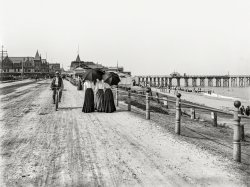
- The Vanderbilt: 1907
- ... Franklin, Model E parked at the curb
(The Gallery, Bicycles, DPC, Syracuse) ... Posted by Dave - 08/18/2015 - 7:59pm -
![The Vanderbilt: 1907 Syracuse, New York, 1907. "Vanderbilt House." With "Credit Parlors," billiards, a bowling alley and Trunks just around the corner. 8x10 inch dry plate glass negative, Detroit Publishing Company. View full size.
Jamestown Exposition "Held in Norfolk, Virginia, from April 26 to November 30, 1907"
Perhaps that narrows the date down a little closer, or maybe they were selling tickets in advance, for $15.45?
[Oh! Good eye. - Dave]
The reason there are no streetcarson those tracks is because they are not streetcar tracks. Syracuse was notorious for its street level railroads with supposedly up to 100 trains a day traveling down the middle of Washington Street (which I believe is the line we see here) by the early 1930s.
There are some pictures in this article about some recently dug up Washington Street tracks.
And more about the early railroads of Syracuse.
Trolley guardsThe tracks coming in from lower right are apparently a steam railroad. The trolley line crossing these tracks has the most common form of trolley guard, a woven metal cage running above the wire, which catches the trolley pole in case of a dewirement, and supplies power for the trolley to get across the crossing. Note that the guards for the two tracks are staggered, so they can protect the pole located toward the rear of the cars.
The guards are probably overkill in this case, as the steam trains would have been moving down the street trackage at very slow speed. However, dewirements were rather frequent, resulting in the conductor grabbing the retriever rope and "fishing" the pole back onto the wire. I've seen it happen many times.
Looking at patent records and Google books turns up some alternative designs, which were apparently unsuccessful.
1907 Pawn Stars?Tried researching "credit parlors" to no avail. Were they turn-of-the-century Amscots? Or were they an early pawn shop? I'm assuming that there was a business relationship to the many nearby billiard "parlors".
[A credit parlor was a clothing store that offered time payments. - Dave]
Come On DownI think what they were really trying to sell were the Railroad tickets.
FrankieLooks like a '05 Franklin, Model E parked at the curb
(The Gallery, Bicycles, DPC, Syracuse)](https://www.shorpy.com/files/images/SHORPY-4a19657a.thumbnail.jpg)
- The Shining: 1939
- ... his death in 1987."
(The Gallery, Arthur Rothstein, Bicycles, Stores & Markets) ... Posted by Dave - 08/27/2018 - 2:00pm -
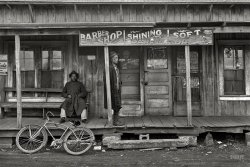
- Nusbaum's Lining Store: 1906
- ... drawers, combinations and the like.
(The Gallery, Bicycles, DPC, Rochester, Stores & Markets) ... Posted by Dave - 07/26/2020 - 10:01am -
![Nusbaum's Lining Store: 1906 Rochester, New York, circa 1906. "Masonic Temple, North Clinton Avenue and Mortimer Street." District headquarters of the Free & Accepted Masons, whose retail tenants include Wunder Tailor, Nusbaum's Lining Store, E.J. Egbert & Co. and Underwood Typewriter. This imposing edifice, completed in 1902, was razed in 1932 to make room for a movie theater parking lot. 8x10 inch dry plate glass negative, Detroit Publishing Company. View full size.
Masonic allegoryThe frieze above the column, an allegory for death and mortality, is referred as the "Broken Column".
Know when to stopThe brickwork above the cornice seems superfluous at best; the acroteria adorning it even more. Perhaps it conceals the mechanicals for the new-fangled elevators, but a more graceful enclosure could surely have been designed.
Can someone explain the Lining Store? Does it possibly supply Wunder, next door? The window display has certainly caught the attention of the only non-smudgeperson in the photo.
Buried TreasureThis great little building was razed in 1932 to create a parking lot for the new RKO Palace theater next door. Recently, both lots were converted to a bus terminal and numerous items from the old lodge were found 30 feet below street level. Story below.
https://paigedoerner.wordpress.com/2014/01/09/masonic-sculptures-discove...
Take your pickThe movie theater parking lot is also gone. Today this location is either a bus station or a parking garage. The loss of this building is a shame. Because of masonic philosophy, their temples are exceptionally well built. There is a recent story of a couple who bought a 90yr+ masonic temple in Huntington, Indiana and are converting it into a private home. The article does not mention any structural problems, plumbing issues, or even a roof leak. Granted, it's challenging to find an alternate purpose for a temple.
Lots to joinThe Lodge appears to have a good assembly of dependent orders also. On the façade I see symbols for the Scottish Rite, the Knights Templar, the Eastern Star, and the Nobles of the Mystic Shrine. I’m not sure what the cornice allegory is about, although it might have to do with Hiram the Widow’s Son. The branch could be the branch of acacia which was supposed to mark his grave.
Lining Store?Like Bob down below, I's be interested to know what the Lining Store provided linings for. A quick dive into Google didn't help.
1906 Drone? How would a photographer get this vantage point? It seems too tall for a ladder, and too close to be from a building across the street. I know they didn't have drones in 1906. Did they?
[For an 8x10 view camera. this is not "too close" to be across the street. - Dave]
Whose Lining?A lining store sold wool, silk, and other fabrics used to line women's skirts. They also sold petticoats and other unmentionables.
Also, today I learned that Li-Ning is a line of badminton gear.
Great minds think alikeArchfan, I must have done the same search as you! Badminton, anyone?
Unconscious Lovecraftian touches?The antifixes (I think that's the right term. I mean the small sculptural features along the top of the roof) have a real Cthulhu vibe to my eye.
[Antefixes. See also: acroteria. - Dave]
The whole thing??An entire store devoted to fabric for linings?!? The mind boggles...
While we still have specialized fiber stores today ( trimmings, closures, quilting, etc ), I've never heard of a lining store.
A testament I suppose to our ancestors' predilections for petticoats, chemises, drawers, combinations and the like.
(The Gallery, Bicycles, DPC, Rochester, Stores & Markets)](https://www.shorpy.com/files/images/SHORPY-4a12119a1.thumbnail.jpg)
- Pan-American: 1935
- ... afford one of them "English racers".
(The Gallery, Bicycles, D.C., Harris + Ewing) ... Posted by Dave - 10/18/2015 - 7:32pm -
![Pan-American: 1935 Ready for international bicycle ride. Henry G. Slaughter of Washington, supported by those interested in publicizing the Inter-American Highway, prepares to leave for a trip which will carry him, if he is successful, down into the tropics through Central America to the Argentine.
November 23, 1935. Washington, D.C. "Henry G. Slaughter." Harris & Ewing Collection glass negative. View full size.
BustA blurb in the Loredo Times from Feb. 6, 1936 reported that Mr. Slaughter decided to abandon "the idea." He had written a friend that he had encountered delays in entering Guatemala on account of very strict laws of entry, and now that the rainy season had begun in that country he had decided to abandon the trip. By June 1936, however, The Carthage Watchman reported that Henry and his handlebar-based typewriter were about to make a second attempt.
Foot HelpI have no idea what was available back in the day, but riding without at least toe clips makes it a lot harder when climbing.
I logged many thousand miles on a bicycle back in the 1970s
including a parts of Montana and Wyoming in 1976.
Gee, I wonder why my knees hurt so much these days?
If you look hardyou can see the revolution counter on the front fork and the pin to turn it on one of the spokes.
I'll wager -I'll bet that he doffs his necktie before he reaches San Luis Obispo.
[Which would have been a major detour on a trip from D.C. to Argentina. - Dave]
Wobble InstabilityYou can pile any amount of stuff as high as you want on a bicycle so long as it doesn't flex under side forces.
Otherwise the bike goes unstable. The front bag looks bad in this regard unless it's all rigid. Also it blocks his light from shining on the road, which in 1935 is surely all potholes.
So I'd guess he didn't make it, unless he piled the front bag in the back and strapped it down.
Incomplete PreparationThis guy isn't fully prepared for such a long trip and doesn't appear to understand what's cool.
For example, he has no streamers coming out of his handlebars, and no playing cards rubbing against his spokes. Nor does he have a hub polisher on either wheel.
Not to mention he's not wearing a bow tie and a houndstooth suit.
Pure Amateur Hour.
I bet he didn't make it.
Story of EvolutionEarly nerd.
Panama or BustHenry had just left San Antonio, Texas and bound for Panama a week after this photo, Methinks there are some inaccuracies abounding. See attached article from the San Antonio Light, published 30 November 1935.
Not So Fast!Seems Henry did make it as far as Panama. May of 1936 had him in front of the US Capitol after a 3400 mile trip. He made the front page of the Erie County Independent. (NY)
At that point he has a typewriter attached to his handlebars to ". . . type notes. . . " - I bet the paper was beat up by the bottom of the page.
Pith Helmet and Linemans bootsJust like they use in the Tour de France.
Wobble InstabilityForgive me for posting twice, but rhhardin's comment about Wobble Instability reminded me of the enormous front basket I had on my one speed J.C. Higgins nerd bike when I was a kid so I could deliver papers.
It had so much weight forward, especially with a load of papers, that I had to be extremely careful making turns, and I dumped it more than once.
I learned to hate that hill I had to climb halfway through my route, and envied those "rich kids" who had parents that could afford one of them "English racers".
(The Gallery, Bicycles, D.C., Harris + Ewing)](https://www.shorpy.com/files/images/SHORPY-39654a.thumbnail.jpg)
- Good Afternoon: 1905
- ... not want to be that hapless pedestrian.
(The Gallery, Bicycles, DPC, Streetcars) ... Posted by Dave - 05/26/2020 - 1:49pm -
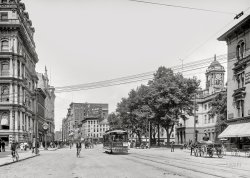
- Small Government: 1937
- ... a house to live in.
(The Gallery, Arthur Rothstein, Bicycles, Cars, Trucks, Buses, Small Towns) ... Posted by Dave - 11/27/2017 - 2:18pm -
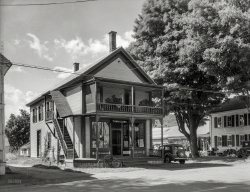
- Cool bike
- ... but not least, we sawed the forks off our old, worn-out bicycles, slid the forks of our new bicycle into them good and snug, and ... have fond memories of Schwinn banana-seat Sting-Ray bicycles such as this. I was totally jealous of the neighborhood boy "Clifton" ... Posted by Gman77 - 05/05/2009 - 6:07pm -
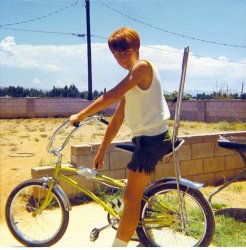
- East Grand: 1902
- ... thoroughfare during their long history.
(The Gallery, Bicycles, Detroit Photos, DPC, Kids) ... Posted by Dave - 10/28/2018 - 11:25am -
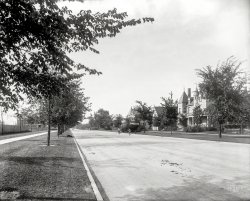
- Rover Boys: 1900
- ... bike lamp in our photo. -Dave]
(The Gallery, Bicycles, Found Photos) ... Posted by Dave - 11/19/2014 - 1:23pm -
![Rover Boys: 1900 Circa 1900, back at the Handlebars Homestead. Lettis, bikes. f5.6 no filter +2" shirts is what it says on the sleeve. 4x5 inch glass negative. View full size.
Interesting TiresThose tires have flat treads and they are made of vulcanized natural rubber (as opposed to synthetic.) I imagine cyclists slid out a lot and got a lot of flats in those days.
Old thoughts exposedI'm not familiar with the abilities of early cameras. However, I wonder if he meant that there were two f-stops difference between the surrounding area under the shade trees and the brightness of the white shirts, and found that f5.6 worked best overall.
Track Stand It's cheating to wedge the rear wheel into a fence to do a track stand.
The rat-trap pedals were current until quite recently, only they'd have an additional strap over the top so you could apply more forward force to the pedal without bending the thing. Nowadays shoe cleats are favored.
Printing instructionsThe info on the sleeve is probably for whomever was printing from that neg. likely the shirts were overexposed and needed an additional 2 seconds of exposure (burning in) when printing in the darkroom. F/5.6 would have been the aperture for the enlarging lens.
siding on the houseNote how the siding boards on the house align exactly with the tops and bottoms of the windows. Old-time carpenters adjusted siding spacing to do that. It's a detail you'll never see with modern vinyl or metal siding.
Tires ExposedI've been riding on natural rubber tires year round in Minneapolis for ten years. Smooth ride in the summer and great traction in the winter down to -15° F when I bale. It's funny how modern materials have been hyped for a while when that what they replaced is actually better.
2" shirtsWith reference to the length of the sleeves of the outer shirt of the cigar-chomping, photo-bombing guy who obviously doesn't care about his long inner sleeves extending beyond the outer shirt sleeves?
[He appears to be: a. in long johns and, b. not the kind of guy you'd criticize to his face. -tterrace]
I very much agree. I'm a big talker at a distance of 114 years. Oh, and he needs to mow his lawn.
Wait..."Rat Traps" Still PopularCleated or "clipless" pedals are used almost exclusively in road racing where a secure foothold is adventageous and some power may be transmitted on the upstroke. However, for single-track biking, mountain biking, cyclocross and other cycling competitions where the rider needs to constantly and quickly drop a foot, not only are cleated/clipless shoes a hinderance, so are the straps of "rat trap/mounse trap" style pedal clips. In these cases strapless toe clips and even no clips, just a simple platform pedal are preferred. Also many bike commuters and touring bikers prefer "rat trap/mouse trap" pedals which allow for the use of regular shoes for ease of walking and lower cost since cleated bike shoes cast more and must be used with "clipless" pedals.
However there is no denying the popluarity of "clipless" pedals among casual riders.
Acetylene Lamps Well Into the 1950sThat "steampunk" acetyline headlamp reminded me of a bicycling memoir I read a couple of years ago where the author wrote about touring the Welsh countryside in the late 1950's and early 60s with acetylene headlamps.
[That's a paraffin bike lamp in our photo. -Dave]
(The Gallery, Bicycles, Found Photos)](https://www.shorpy.com/files/images/SHORPY-GN-016.thumbnail.jpg)
- Old Hat: 1920
- ... the left has much more to offer. Indian brand motorcycles, bicycles and tricycles are all on display. What a treasure trove. Also,the ... Posted by Dave - 04/06/2013 - 12:01pm -
![Old Hat: 1920 Washington, D.C., circa 1920. "814-816 Ninth Street N.W." Moldy negative of a decrepit storefront, with many musty details. National Photo Co. View full size.
Motocycles?I just learned that the folks at Indian didn't know how to spell "motorcycle."
The Indian Motocycle shopI find the partial view of the Indian Motocycle shop more interesting than the almost-derelict storefront that's the subject of the photo. Here's a photo of a 1920 Indian Motocycle; the "Indian" name and the fuel tank (I assume) it's on look the same as in the window of that shop.
http://parkerindian.com.au/1920PP.html
"Silent" OlsonThe poster above the For Rent sign is for a wrestling match between Joe Turner and Silent Olson, a deaf-mute.
"Christmas night he beat Joe Turner, for ten years champion middleweight wrestler."
They came and went.BEAUTIFUL Indian in the window next door.
One please, to go !
Washington RedskinsWhile the out of business hat store has its decrepit charm the store to the left has much more to offer. Indian brand motorcycles, bicycles and tricycles are all on display. What a treasure trove. Also,the reflection in the hat store window shows cars in the street and what looks like someones legs on a ladder or scaffold rung. I wonder if it is somebody in the store working or perhaps the reflection of the photographer in the street getting a raised perspective. The Gold Medal Flour sign up above states "Why Not Now?" No time like the present indeed.
Elementary ParticlesNot sure, but that curved white line with the little black teardrop at the top ... I think it's the Higgs Boson!
New HatIt's all gone now, replaced by the U.S. Mint Headquarters.
View Larger Map
Lady of the Lamp Looks like she left it on the sidewalk in front of the Indian dealership. Also looks like the rear of the hat store has collapsed.
Sniper!Top window, second floor! Or maybe it's some sort of Rube Goldberg drainage system.
The Lady of the LampThe sign in the window to the right is a play by Earl Carroll, closed November 1920. The sign states Dec. 6. Seems it never made it to that date.
http://www.ibdb.com/production.php?id=8963
[December 6 is the performance date in Washington. The Broadway Database dates are for performances on Broadway, in New York. - Dave]
Motocycles and motorcyclesThe corporate name was always "Indian Motocycle Company" but it made motorcycles and advertised them as such. Well the nearly new 1946 Chief I owned was called a motorcycle, but company name was still "Motocycle." Dang, I sold the thing for $75 in 1958 to a guy who had never ridden one. I had to drive the bike into his pickup truck and he said he was going to unload it in a 40 acre pasture and learn to ride. He figured there weren't many things to hit in a pasture except for the cow patties.
Too dark to see in the daytimeWhat's with the kerosene lantern on the sidewalk?
Now a Parking LotNo, not the U.S. Mint headquarters; that's on the east side of Ninth Street, the odd-numbered side. Where 814-816 Ninth Street was is now a vast parking lot, where the old new Convention Center used to be, till it was mercifully torn down. Even a parking lot is preferable to that awful building. If the Hoover FBI building and the OPM building at 20th and E could go the way of the old new Convention Center, even if they became nothing but parking lots, Washington would be a better place.
F.L. Leishear, Indian MotorcyclesThat's F.L. Leishear's motorcycle shop to the left, also seen in Shorpy post Wireless Apparatus: 1919. The previously open D. Neufeld Hat Manufacturer has since closed and lost its most prominent signage.
Washington Post, Jun 23, 1921
Motorcycles
PRICES reduced 20% on new 1921 Indian motorcycles and side cars; also used machines at exceptional prices. F.L. Leishear, 812 9th st. nw.
A LeopardIt seems strange that there is a leopard skin in the Indian window.
One item that Indian made that does not appear to be on display is a canoe and trailer that can be used with a motorcycle.
(The Gallery, D.C., Motorcycles, Natl Photo, Stores & Markets)](https://www.shorpy.com/files/images/29720u.thumbnail.jpg)
- The Gospel Wagon: 1900
- ... Services - the forerunner of the CIA.
(The Gallery, Bicycles, Buffalo NY, DPC, Stores & Markets) ... Posted by Dave - 09/16/2017 - 9:43am -
![The Gospel Wagon: 1900 Buffalo, N.Y., circa 1900. "Ellicott Square Building." At the time of its completion 1896, the largest office building in the world. Our title for this post comes from lower down (and higher up). 8x10 inch glass negative. View full size.
I like the Gospel Wagon idea..At least there not out knocking on your door during the Pittsburgh Steeler games.
Progressive?What does one sell in a "progressive" store?
["Progressive" as in the sense of "modern," as in this article, which seems unintentionally prescient. -tterrace]
Phoenix Reflected The Phoenix Brewery, (a very popular name used through out the country), operated in Buffalo from 1887 to 1920, closed for prohibition from 1920 to 1934, operated again from 1934 to final closing in 1957. The title refers to the "BEER" reflection in one of the store windows across the street to the left.
Signs of the TimesThere are at least five separate railroad ticket offices in the building: Erie; Pennsylvania; Buffalo Rochester and Pittsburgh; Chicago and Northwestern, and Nickel Plate. There may be more, but they're too fuzzy to read. Also like the interesting phonograph store selling Columbia and Edison cylinders and players (no they were not compatible).
Ministering On Main StreetThe Ellicott Square Building (283-309 Main Street) was completed in mid-1896 and still stands today. Six workmen died during the building's construction. Across the street was 304 Main, home to Palmer's Florist and the Albany Dental Parlor. “Sam. Welsh's Progressive Store” was the cigar store of brothers Samuel and Charles E. Welsh. They opened their 311 Main Street store in November of 1899, having previously operated the Progressive Cigar Store at 331 Main Street. Perhaps the Gospel Wagon Association thought that those buying cigars and phonographs needed to be exposed to something a little more “redeeming.”
Sidewalk Sign DesignI am interested if anyone knows the purpose of the signs placed along the sidewalks, which seem to be advertising above, and vertical bars of some sort below. Perhaps stops for public transportation, but why so many? And what are the bars for? A classic Shorpy mystery for me.
[A rare sight in early Shorpy street scenes: a bicycle rack, like the one in use here. -tterrace]
Future office of Wild Bill DonovanWhen this was taken, a local Buffalo teen named William Joseph Donovan was in St. Joseph's Collegiate Institute, with big dreams. He would enroll in Niagara University for two years before transferring to Columbia, where he received a B.A. and law degree. Returning to his hometown, "Wild Bill" went into private practice with Love & Keating in 464 Ellicott Square. He would remain there until he scratched the itch to form his own law firm in 1912. O'Brian, Hamlin, Donovan & Goodyear moved into the brand-new Iroquois Gas Building. Donovan's office grew dusty as he devoted more and more time to reawakening New York's militia and turning it, by 1917, into the "Fighting 69th" New York Infantry. As its colonel, Donovan became nationally famous, leading to a series of positions that would culminate as his appointment during World War II to begin the Office of Strategic Services - the forerunner of the CIA.
(The Gallery, Bicycles, Buffalo NY, DPC, Stores & Markets)](https://www.shorpy.com/files/images/SHORPY-4a29267a1.thumbnail.jpg)
- Louisville Levee: 1905
- ... L&N at the time of its construction.
(The Gallery, Bicycles, Boats & Bridges, DPC, Louisville) ... Posted by Dave - 08/13/2013 - 3:45pm -
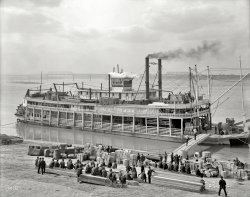
- Market Street: 1905
- ... 2 glass negatives of this area with people walking, riding bicycles, horse and buggy, but no vehicles. I don't see the arch in this ... Posted by Dave - 07/26/2012 - 12:31pm -
![Market Street: 1905 Market Street at Eighth in Philadelphia circa 1905, with the Lit Brothers building at right. Detroit Publishing Company glass negative. View full size.
Don't Make 'Um Like They Use TaThe architectural variety in this picture is just amazing. This makes my jaw drop much further than any modern skyscraper.
Modern LifePopping out of a subway tunnel and into the hustle and bustle of the big city, anyone would think this is modern times until they saw the clothes and the horses. So much is going on!
Market Street, PhiladelphiaI was stationed in Philadelphia with the Navy, 1957-59. The trolley cars were still active when I first arrived. We rode them many times from the Navy Base into center city. Many streets were still cobblestone at that time. I met my wife there and we will have been married 49 years in a few days.
PhillyphileThanks for the photo. I work in Philly and have lived here all my life. I love old pictures of the city.
Philly SubwayWas there really a subway in 1900? Wikipedia seems to say there wasn't one at that time. Is it like one of those London subways, which is really just a tunnel from one side of the street to the other?
Lit BrothersThe Lit Brothers and the Strawbridge & Clothier buildings are both standing but sadly not as department stores. The Strawbridge building is on the other side of 8th street. Both are used as office space.
BuzzedAbout ten years after that photo was taken, my grandfather and a friend of his who owned a plane flew down Market Street between the buildings. It hadn't been made illegal yet.
Philly UndergroundAccording to:
http://www.urbanrail.net/am/phil/philadelphia.htm
Market-Frankford Line
1907: 69th St- 15th St (all elevated)
1908: 15th St - 2nd St (underground)
1915-1922: 2nd St - Frankford (Bridge-Pratt) (elevated)
1955: 40th St - 15th St rebuilt underground
Philadelphia SubwayOpened December 1905.
That's where I am right now!As I read this I am currently on the 4th floor of the Lit Brothers Building, which still looks much the same, though due mostly to an extensive restoration about 15 years back. And indeed it is mostly offices with a Ross Dept. Store on the 1st floor. The IRS and Mellon Bank have offices there. Many of those buildings are still there (at least more than I'd have thought) though they've gone through that very unfortunate phenomenon of the 70's and 80's where some nitwit decided to "wrap" the 1st floor (and some 2nd) facade in retail crap decor, which ages horribly and ends up looking crappier than you can imagine. But then you look UP and see all this wonderfully ornate and diverse architecture. Its a bit of a split personality disorder. For instance Thomas Eakins' studios were in this utterly fantastic Second Empire (I think) style corner building. It is so detailed and gorgeous, but some nut job (apparently not stopped by the city or any historic commission) wrapped the bottom in an atrocious Valu-mart, which is in very poor disrepair. But look up and you are like "Holy Crap!"
Plus it's neat to think that, while highly unlikely, one or two of those busy bustlers were my great grandparents who lived and worked downtown, right during this period. Could be, anyway, right?
Market StreetWow. I lived in Philly for eight years near Market Street, which I walked frequently from Olde City to Broad. The scene looks remarkably similar today. As a previous commenter mentioned, the altered first-floor facades really trashed up the appearance of the architecture, but above those I would say more than a good half of the buildings in the pic still look the same. One of the truly remarkable things about Philly is its architecture. Unfortunately most people forget to look up a little when walking down the street.
Market Street Subway.The Market Street subway was always underground from river to river. The extension in the 1950s buried the elevated portion from 23rd to 46th streets. It was never elevated at 15th.
Question about buildings.What is the name of the building in the center, with the clock tower and man on top? Also the building to the left of it that has a pagoda looking top. I have 2 glass negatives of this area with people walking, riding bicycles, horse and buggy, but no vehicles. I don't see the arch in this picture.
[The building with the clock tower is City Hall. - Dave]
(The Gallery, DPC, Philadelphia, Stores & Markets)](https://www.shorpy.com/files/images/4a19437u.thumbnail.jpg)
- Special Delivery: 1917
- ... stamps bore illustrations of such uniformed boys riding on bicycles:
The Mailman Cometh I second your comment with a hubba ... Posted by Dave - 08/27/2012 - 2:41pm -
![Special Delivery: 1917 Washington, D.C., circa 1917. "Post Office postmen on scooters." Kind of a Segway vibe here. Harris & Ewing Collection glass negative. View full size.
Cool old scootersEarly Autoped Ever-Ready scooters. They were new in 1914, according to Wikipedia, so that narrows the date of the photo down a bit.
[Thanks! Below: Article from 1914, ad from 1916. - Dave]
I wonderI wonder why these didn't catch on? They look almost identical to some of the *extremely* noisy motorized scooters we have today. Perhaps they broke down, or they made an ungodly racket, or people just weren't so walking-averse as they are today.
Wonder no more:You hit a small rock or crack in the pavement and over the handle bars you go. Perhaps too many carriers were going onto the injured list.
Flash in the Pan?Looks like they had the staying power of Segues, also.
Smithsonian has oneIt's here. A 1918 model with some usability improvements but not as spiffy looking.
HuminaThey don't make mailmen the way they used to.
Pretty simple design.Looks like its basically a horizontal shaft engine with the front wheel being attached to the shaft, with some sort of clutch mechanism. Guess it gave mailmen the chance to get away from the local dogs.
ReflectionsIn the window, you can just barely see a sign for the Hotel Harrington (which would put this at least after 1914). That would mean that this could be the post office on Penn between 12th and 13th.
Cool it ain'tDo you suppose these men felt as dorky as they look?
Precursor to SegwayWow, you'd think we would have learned our lesson already. Remember how the Segway was going to change the world?
I think they are used in Post Offices (somewhere), and I have seen police use them.
Scoot!"Wow, you'd think we would have learned our lesson already. Remember how the Segway was going to change the world?"
Not at $5,000 each (the price that I've seen), they wouldn't.
Special-Delivery MessengersThese aren't regular letter carriers, aka mailmen, but special-delivery messengers. According to Sec. 864 PL&R (Postal Laws and Regulations) of 1913, these could be, at the discretion of the local postmaster, "boys 16 years of age or older." Contemporary Special Delivery postage stamps bore illustrations of such uniformed boys riding on bicycles:
The Mailman ComethI second your comment with a hubba hubba. Forget the milkman, bring on the mailman!
Scooter spot todayThis was at the Main Post Office (now the National Postal Museum) adjacent to Union Station. Here's the spot today, on North Capitol St. NE.
View Larger Map
(The Gallery, D.C., Harris + Ewing)](https://www.shorpy.com/files/images/06878a.thumbnail.jpg)
- Boiled Dinners: 1910
- ... that it's more likely to be 1908 or '07.
(The Gallery, Bicycles, Detroit Photos, DPC, Streetcars) ... Posted by Dave - 02/10/2017 - 7:42pm -
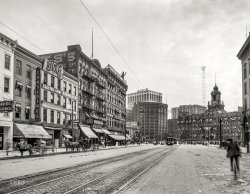
- Grass Routes: 1940
- ... like Kansas City or even farther!!!
(The Gallery, Bicycles, M.P. Wolcott) ... Posted by Dave - 03/20/2017 - 1:03pm -
